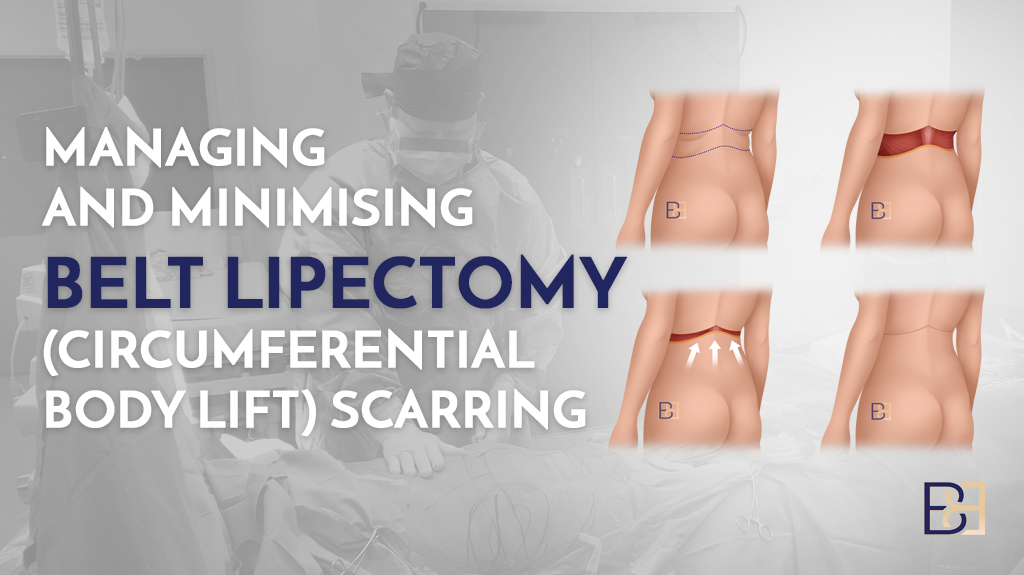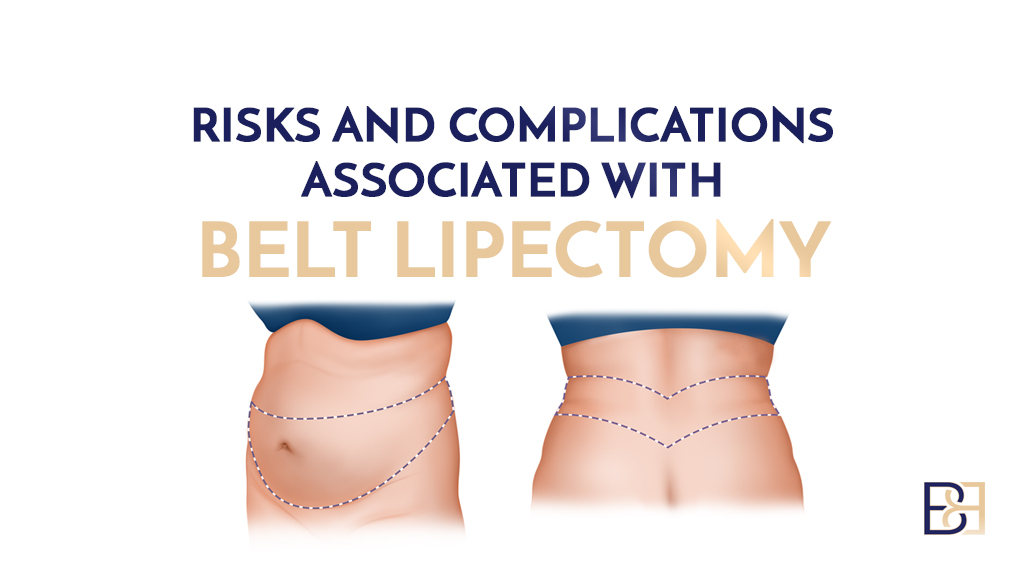Many of my patients ask me to explain the difference between lower body lift (Belt lipectomy) surgery and abdominoplasty surgeries and which one is better for getting rid of excess skin and fat on their midsections after weight loss. Let’s explore what sets these two surgeries apart.
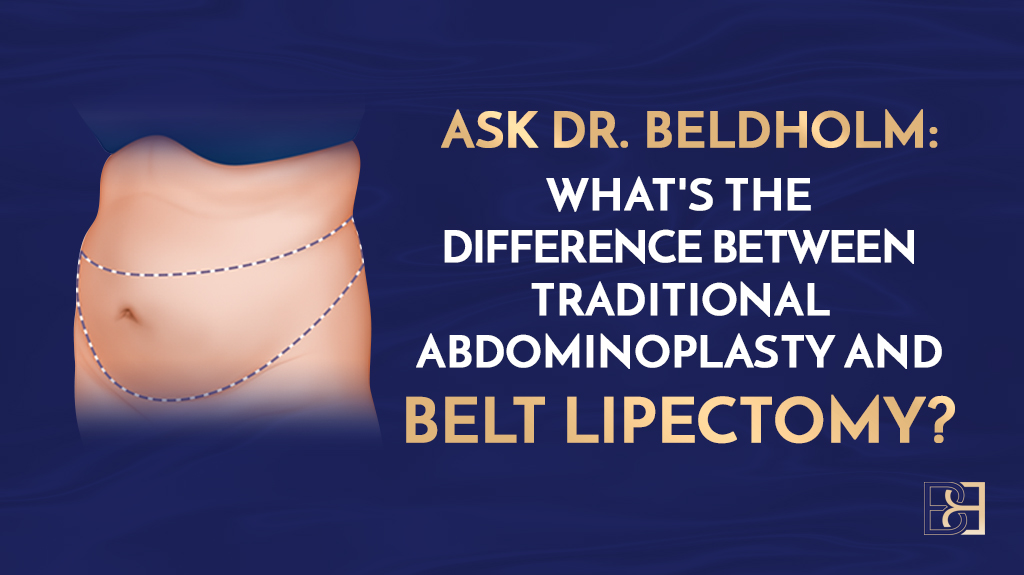
Book your appointment online now
How Belt Lipectomy and Abdominoplasty Differ
An abdominoplasty removes loose skin and fat. Unlike an abdominoplasty, which won’t target the buttocks, flanks, or thighs, a belt lipectomy targets all of these areas as well as the mons pubis, the fatty area in the upper pubic region just below the bikini line (FUPA). Both surgeries include abdominal muscle repair when needed.
What is Belt Lipectomy Surgery?
Belt Lipectomy, AKA lower body lift surgery, is for patients who have experienced significant weight loss and have loose skin 360 degrees around the waistline. One of the most complex excess skin removal procedures available, it removes a substantial amount of excess skin from the front, back, and sides, as well as unwanted fat that’s attached to the loose skin.
Who is Considered a Good Candidate for Belt Lipectomy Surgery?
A good candidate for belt lipectomy surgery should:
- Be in good general health
- Be at or very close to a healthy weight
- Have maintained a stable weight for at least six months before surgery
- Be committed to a healthy lifestyle after surgery to maintain results
- Have Realistic expectations
A good candidate for belt lipectomy surgery should not:
- Have serious medical conditions
- Be pregnant or nursing
- Smoke (or be willing to quit for at least six weeks before and after surgery)
- Have Unrealistic expectations
How Much Does a Belt Lipectomy Cost?
A Belt Lipectomy is more involved than standard or extended abdominoplasty, as it will remove loose skin on the tummy, hips, back, and buttocks. This also makes this procedure significantly more expensive, surgical fee starting at $25,990.
Numerous factors affect pricing as every patient is unique. In order to provide you with the most accurate price estimate, I will need to meet with you to examine your concerns, take a medical history, and discuss your goal and expectations. You’ll receive a price quote after your initial consultation with me.
Will Medicare Cover a Belt Lipectomy?

Medicare could cover a portion of your belt lipectomy if the procedure is medically necessary. The Medicare item number for belt lipectomy is 30179. If you qualify, you can get a partial rebate from the government to cover some of the out-of-pocket surgical costs. Not all patients qualify for a Medicare rebate. For example, a belt lipectomy performed purely for cosmetic reasons would not qualify.
Main Requirements for Medicare Item Number
- Documented medical issues like rashes or skin irritations that haven’t resolved with conventional treatment
- Must have lost at least five BMI points and kept your weight steady long-term
If you are interested in applying for a Medicare rebate, I’ll be happy to speak to you about all of this during our consultation.
Will Private Insurance Cover Belt Lipectomy Surgery?
Private health insurance generally will cover some of the hospital costs as long as you meet the criteria listed in the Medicare Benefits Schedule for a belt lipectomy. You’ll need to check your health plan to see what’s covered.

Risks and Complications of body lift (Belt lipectomy) surgery
A belt lipectomy is a major surgical procedure with higher risks than a full or mini abdominoplasty because we are working on multiple body areas at once.
During your initial consultation, I’ll review the risks of surgery with you, such as infection, poor wound healing, unsightly scarring at the incision site, bruising, excess fluid collections, a blood clot that could lead to pulmonary embolism, additional revision surgery, sutures spitting out, etc.
This isn’t meant to scare you; I want to make you aware of any potential complications and risks, no matter how likely or unlikely, so you can make an informed choice before proceeding with your surgical procedure.
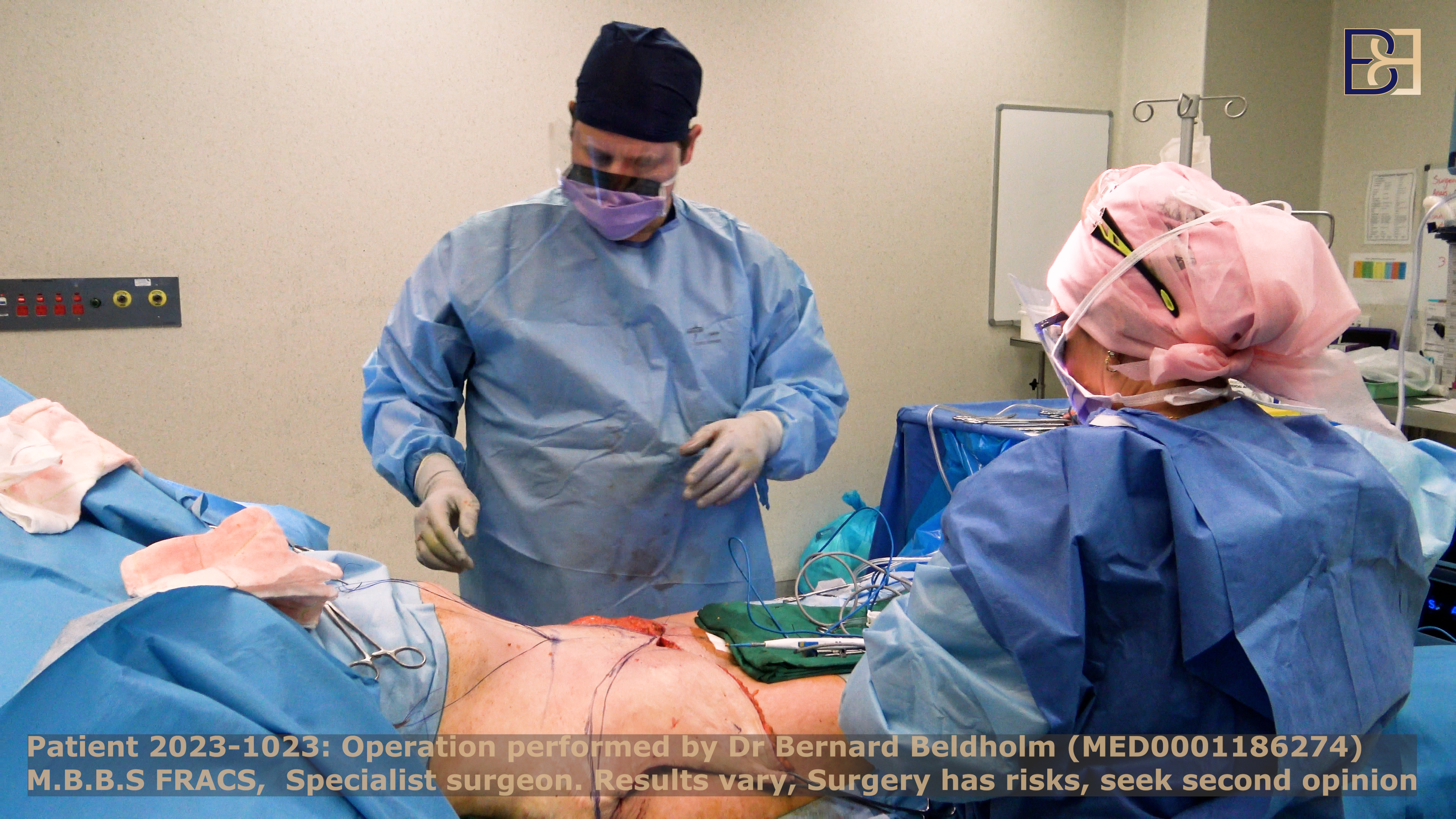
Belt Lipectomy Surgery Overview
Although your surgical plan may vary, here is an idea of what usually happens during the operation.
Markings are Drawn
General Anaesthesia is Administered
Surgery Begins
Body Positioning
You’ll start lying on your back (face up) so I can perform surgery on the front areas first.
Extended Abdominoplasty with VASER Liposuction (suction-assisted lipectomy)
As you lay in the supine position (facing upwards), VASER liposuction (suction-assisted lipectomy) is performed, focusing on the excess fat on your abdomen and sides.

Freeing the Umbilicus
The next step is freeing the navel and making an incision across the waist and around the hips. Again, I’ll remove the excess skin with precisely measured cuts.
Repair Muscle Separation

If you have loose abdominal muscles, I will bring the muscles together with sutures.
Umbilicus Repositioning

Next, I’ll create a new hole for your belly button. It generally needs to be repositioned; otherwise, it might sit too low on your tummy once I pull the incision closed.
Closing the Incision
Next, I’ll close the incision in layers with sutures and medical-grade skin adhesives.
Turning Over
My O.R. staff and I will carefully turn you over so I can begin operating on your back and sides.
VASER Liposuction (suction-assisted lipectomy)

I usually perform VASER liposuction before removing any skin. The VASER probe removes unwanted fat by melting it and then extracting it through a thin tube. It also makes it easier for me to dissect the tissues.
Excess Skin and Fat Removal of the Buttocks and Lower Back
I’ll place an incision across the back of your waist. Through the incision, I’ll measure and trim off the excess skin and, along with it, the attached subcutaneous fat.
Closing the Incision
I’ll close the incision in layers and use a special medical glue to avoid the need for surgical drains. The glue closes all the gaps in the dissected tissues so fluid doesn’t build up.
PICO Dressing Applied

The last step of the surgery involves applying PICO Negative Wound Dressing to aid healing. Designed to promote the healing of body contouring wounds, I utilise the PICO 7 negative pressure wound system for almost all of my body contouring patients.
Compression Garment Applied
Length of Belt Lipectomy Surgery: Seven to eight hours.
Belt Lipectomy (Lower Body Lift) Recovery
Here is an overview of what a belt lipectomy recovery typically looks like. Your individual recovery experience may vary.
Recovery Timeline
Day 1
Expect some grogginess and discomfort. The operable areas will be quite swollen and may be bruised. I’ll encourage you to get up and start walking slowly the same day, keeping your waist bent.
Week 1
The worst of your soreness should ease up after a few days, but tenderness and aching can last longer. You’ll stay in the hospital for a majority of the first week, from five to seven days at minimum.
Week 2
At this point, you should be home, taking it slow.
Family members should aid you with everyday tasks and look after you. You can have a light rinse in the shower, but don’t get the PICO wound dressing wet. At this point, you’ll also need to come into my office for a follow-up appointment. I’ll swap out your PICO dressing for Hypafix tape, which can get wet. You can have a full shower after this.
Weeks 3-5
Light exercise can resume in most cases during this stage of recovery. You must avoid strain and lifting heavy items, but longer walks and light aerobics are usually okay. Most of the soreness should have tapered off, but there can be a bit of lingering aching and numbness in the surgical areas. Driving and working can resume in three to four weeks if you feel up to it unless you have a physically demanding career.
Weeks 6-8
Most of my patients are cleared for jogging, weight lifting, and full aerobics at this point in recovery. Swelling and aching are typically greatly diminished at this stage, although occasional nerve pain and numbness may persist for a few months.
Month 3
Most of my patients feel more like themselves at this point, with nearly 60% of the swelling resolved.
Months 6-12
The final results of your surgery should begin to unfold as your tissues relax.
Months 12-18
It can take a year to a year-and-a-half to see your final results. Your scar should have faded substantially after the first 12-18 months. Scar revision and laser treatments can be performed if needed to minimise scarring.
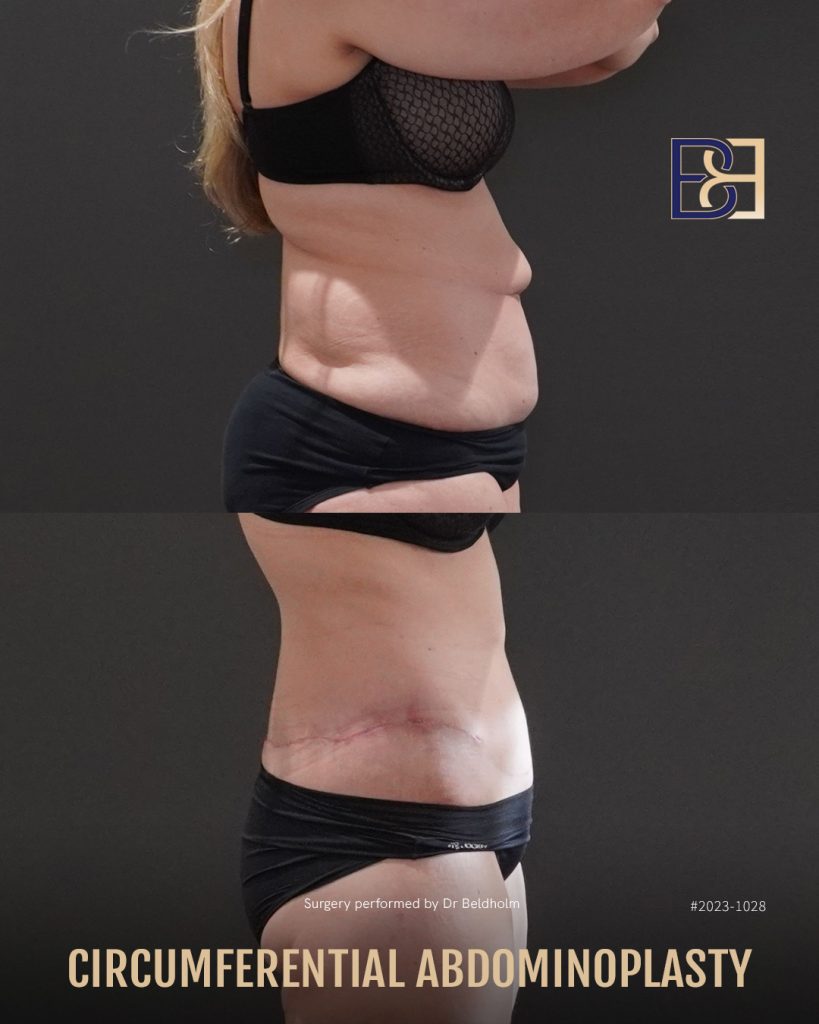
Disclaimer: Operation performed by Dr Bernard Beldholm. Adult content, surgery has risks; individual results vary, seek 2nd opinion. Please see the full disclaimer.
Belt Lipectomy Recovery Guidelines
- Driving. Please wait at least three to four weeks before getting behind the wheel. Someone will need to drive you to and from your follow-up appointments at my office.
- Returning to Work. If you have a sedentary job, you should be back to work within roughly three to four weeks. Those with careers requiring physical exertion will need to wait a bit longer.
- Resuming Your Exercise Routine. While you should be able to walk from day one, allow a minimum of six weeks before resuming your full exercise routine. Light aerobics are usually okay within three to five weeks.
- Incision Aftercare. Keeping your incision clean and avoiding sun exposure once the incision heals are the keys to reducing scarring.
- Showering. Bird baths are okay during the first seven to nine days, but you won’t be able to take a full shower until I remove the PICO dressing (which cannot get wet) and replace it with medical tape.
- Swelling. Swelling can be extreme after surgery but should diminish greatly within the first few months.
- Pain Management. To ease discomfort during your early recovery, you may be prescribed pain medication as needed.
- Sleeping. I’ll recommend sleeping on your back with your head elevated and waist bent for the first few weeks after surgery. This position takes tension off the abdominal wall and incision.
For more information about this procedure, please see my article, Your Complete Guide to Belt Lipectomy (Lower Body Lift) Surgery After Weight Loss.

Disclaimer: Operation performed by Dr Bernard Beldholm. Adult content, surgery has risks; individual results vary, seek 2nd opinion. Please see the full disclaimer.
Abdominoplasty Surgery
Abdominoplasty mainly targets firmness and tightness of the upper and lower abdomen. It may also have a somewhat lifting effect on the mons pubis. The surgery can also correct abdominal muscle separation. There are many different types of tummy tucks that I can customise to target your unique concerns.
Types of Abdominoplasty by Concern
Mini Abdominoplasty
A mini abdominoplasty tightens skin below the Umbilicus only. It won’t treat the upper abdomen or fix abdominal muscle separation.
Full VASER Lipo-Abdominoplasty
A full Abdominoplasty corrects the upper and lower abdomen. It can also be done to repair abdominal muscle separation.
Extended Abdominoplasty
An extended Abdominoplasty removes loose skin from the abdomen and hips. It has a longer incision than a full Abdominoplasty.
FDL Abdominoplasty
A fleur-de-lis Abdominoplasty uses two incisions (one placed vertically and the other horizontally). This allows me to remove excess skin from all areas of the frontal abdomen while also narrowing the waistline.
Who is Considered a Good Candidate for an Abdominoplasty?
You could be a candidate for tummy tuck (abdominoplasty) surgery if you have excess skin and resistant fat on your upper or lower abdomen after weight loss. You must be reasonably fit, near your ideal weight, and not pregnant or nursing. You also shouldn’t smoke, or at least be willing to quit for a while. The ideal candidate doesn’t have any serious medical conditions that would make it too risky to have surgery. Your medical history, weight consistency, and lifestyle can also factor into whether you’re eligible. You must also not have mental health issues such as body dysmorphia and have realistic expectations. You will need to book a consultation with me to determine whether or not you’re a candidate.
How Much Does an Abdominoplasty Cost?
Mini Abdominoplasty – Surgical fee from $6,990
A mini abdominoplasty is the least invasive procedure I offer. It involves removing redundant excess fat and skin only on the lower abdomen (below the belly button). The procedure may also include repairing separated abdominal muscles (diastasis recti) if needed.
As there are many variations and options possible for this operation, please refer to my related post, Guide to Mini Abdominoplasty Rates, for a complete breakdown of the costs and procedures involved in a mini tummy tuck.
Full / Standard Abdominoplasty: Surgical fee from $10,990
A full abdominoplasty is the standard procedure to remove redundant skin on the whole abdomen (above and below the belly button). The procedure also involves repositioning the navel (belly button) and correcting diastasis recti (separated abdominal muscles), making it more invasive, and, thus, more expensive than a mini tummy tuck.
Because there are many variations and options possible for this operation, please refer to my related article, Guide to Full Abdominoplasty Rates, for a breakdown of the costs and procedures involved in a full tummy tuck.
Extended Abdominoplasty Surgical fee from $12,990
The extended abdominoplasty procedure treats redundant skin on the upper and lower abdomen and the flanks (side). It also repositions the belly button and corrects diastasis recti when needed.
Because there are many variations and options possible for this operation, please refer to my related article, Guide to Extended Abdominoplasty Rates, for a breakdown of the costs and procedures involved in an extended tummy tuck.
Fleur-de-Lis Abdominoplasty – Surgical fee from $14,990
For patients who have lost a significant amount of weight, a standard or full abdominoplasty may not be enough to fully flatten their abdominal area. In this case, I may recommend a Fleur-De-Lis Abdominoplasty. This type of Abdominoplasty removes and tightens the skin of the abdomen in both vertical and horizontal directions.
During the procedure, I may also remove some additional fat and repair abdominal muscles as needed, just like with a standard tummy tuck. Because there are many variations and options possible for this operation, please refer to my related article, Guide to Fleur-de-Lis Abdominoplasty Rates, for a breakdown of the costs and procedures involved in an extended tummy tuck.
For a complete guide to Fleur-de-Lis, read our article, Dr Beldholm’s Step-by-Step Guide to Fleur-de-Lis Abdominoplasty.
Reverse Abdominoplasty – Surgical fee from $10,990
Reverse abdominoplasty differs from the other abdominoplasties because it targets redundant skin and separated muscles in the upper abdominal region. The procedure’s incision runs across the bra line. I recommend this abdominoplasty to patients who are undergoing a breast lift (mastopexy).
Note: I usually revise the prices at least every six months. Therefore, these prices are only accurate as of the date of this publication and may be subject to change.
Book your appointment online now
Will Medicare Cover an Abdominoplasty?
If your procedure is deemed medically necessary, as opposed to purely cosmetic, the Australian Medicare system has an MBS Item Number for abdominoplasty post-weight loss for patients. Medicare won’t cover the full cost of surgery, but qualifying patients can receive a partial rebate after paying for the procedure out of pocket.
I’ll walk you through the other criteria for the abdominoplasty MBS Item Number if I think you are eligible to apply.
For more information, refer to my article Obtaining Medicare Coverage for Abdominoplasty Surgery (Tummy Tuck) in Newcastle, NSW.
Will Private Insurance Cover Abdominoplasty Surgery?
Private health insurance may cover some of the hospital charges if you have a gold-level plan. The catch is you’ll need to meet the criteria for the MBS item number to qualify. Be sure to check with your health insurance carrier since each plan differs on what services they’ll cover.
Benefits of Abdominoplasty
Abdominoplasty aims to make the abdomen firm and taut. As with a belt lipectomy, I frequently use VASER liposuction (suction-assisted lipectomy) for Abdominoplasty procedures. This helps to highlight the abdominal muscles and make the tummy contours look more natural. Finally, I can suture the six-pack muscles together if you have loosening or separation. Removing excess skin and fat may help your tummy appear flatter and possibly allow your clothes to fit better. If you have irritation from excess skin rubbing together, a tummy tuck (abdominoplasty) can also resolve this.
Risks and Complications
I always make time to review the risks of surgery with my patients. The risks are infection, necrotic skin, wound breakdowns, visible scarring, prolonged discomfort in recovery, a haematoma in the underlying tissue, fluid accumulation, excess blood loss, nerve damage, loss of skin sensation, blood clots, needing further surgery, and more. I’ll go over all this with you at your consultation and will be happy to answer any questions you may have.

Abdominoplasty (Tummy Tuck) Operation Overview
While every tummy tuck (abdominoplasty) surgery is customised to the patient, this is a basic idea of how the operation works.
Markings are Drawn
I’ll draw markings on your skin in the anaesthetic bay before your surgery.
General Anaesthesia is Administered
Once in the operating room, my anaesthetist will administer a general anaesthetic through an IV.
Surgery Begins

Body Positioning
You’ll lie on the operating table in a supine position (facing up).
VASER Liposuction (suction-assisted lipectomy)
I usually first perform VASER liposuction (suction-assisted lipectomy) to remove excess abdominal fat. The VASER probe melts the fat before I extract it.
Excess Skin and Fat Removal
For a full or extended Abdominoplasty, I’ll free your navel so it can be moved later on in the surgery. I’ll dissect the tissues and repair any abdominal muscle separation or umbilical hernias if needed before removing the loose skin.
Umbilicus Repositioning
I will pull the belly button stalk through a new hole so it sits in a natural position. Otherwise, it might sit too low on the abdomen when I pull the incision closed.
Closing the Incision
I will close the incision in layers and apply a spray medical glue that seals gaps in the tissues where fluid can collect. This allows me to avoid surgical drains.
PICO Wound Dressings Applied
I will apply the PICO negative pressure wound dressing. It’s a soft bandage attached to a battery pack that applies negative pressure to the wound to accelerate healing. You’ll wear this bandage for about a week.
Compression Garment Applied
Before you wake from surgery, I’ll place a soft, stretchy compression garment around your abdomen.
Length of Abdominoplasty Surgery
The surgical time for abdominoplasty varies widely depending on the extent of the concerns. While a mini Abdominoplasty may take only one to two hours, a full Abdominoplasty operation with VASER liposuction (suction-assisted lipectomy) usually takes upwards of five hours. Although I don’t want you to stay under general anaesthesia for too long, I never rush the process. I’ll take the time needed to give you the highest chance of achieving your goals.
Abdominoplasty Recovery Timeline
You’ll likely spend a few days in the hospital before returning home to recover. Many patients return to work/driving in two to three weeks, but a full recovery takes additional time.
Day 1
Grogginess and moderate soreness rule the day. I’ll check in with you to see how you’re feeling. You’ll likely spend three to six nights in the hospital.
Week 1
You’ll be in the hospital most of this week. You’ll be able to walk slowly, slightly bent at the waist. The day or two after surgery is when pain typically peaks, but you’ll have medication for pain management. Swelling in the treated areas can be substantial. No strenuous activities or heavy lifting are allowed, but you can walk for exercise.
Weeks 2 to 3
Seven to nine days after your surgery, I’ll remove the PICO wound dressing and replace it with medical tape. You can have a full shower after this. You’ll still be quite swollen and may have some bruising, but your incision should have healed over by now. By day 10, you’ll most likely be walking fully upright. You may feel up to returning to work and driving after two to three weeks. Patients with physically active careers should plan to take extra time off work.
Months 1 and 2
A month after your surgery, the swelling should have eased up some. If everything is healing as expected, you can increase your physical activity to include jogging and vigorous exercise.
Month 3
By now, numbness in the treated areas should subside and swelling continues to resolve. Most of my patients say they feel more like themselves again and they can usually resume all activities without restriction.
Months 6-12
With nearly all of the swelling gone, the abdominal tissues feel less hard and firm. The scar begins to fade but may remain dark for some time. You’re getting closer to your final result.
Months 12-18
This is when you’ll see your final abdominoplasty results. Your scar should continue softening up and losing pigment over time.
Abdominoplasty Recovery Guidelines
Driving. After a tummy tuck, driving can resume two to three weeks later.
Returning to Work. Most of my patients feel well enough to go back to sedentary jobs, but those with physically demanding careers will need a little more time to recover before returning to work.
For more information, refer to my article, When Can I Go Back to Work After an Abdominoplasty?
Resuming Exercise Routine. Physical activity such as walking and light aerobics can be great after taking a couple of weeks off to recover. You won’t be cleared for heavy lifting, jogging, or strenuous exercise for at least four weeks.
Incision Aftercare. Keeping your incision clean is paramount. Otherwise, you’d run the risk of an infection. You can wash the incision area gently with mild soap once you’re cleared to have a full shower, but avoid harsh scrubbing.
Showering. I advise my patients to take bird baths until I change the PICO battery-powered wound dressing out for Hypafix tape. That usually happens seven to nine days after surgery.
Swelling. Swelling can be extreme at first due to the invasive nature of the surgery. Your tummy should be much less swollen after three months. Residual swelling can remain for six months to a year.
Pain Management. Pain after tummy tuck surgery is managed with approved pain relievers.
Sleeping. Sleeping with your head raised on pillows and your waist bent will be most during the first few weeks.
Cost Comparison: Abdominoplasty vs. Lower Body Lift (Belt Lipectomy)
Body contouring surgery can be costly. Even with a Medicare rebate and private health insurance, you’ll still have out-of-pocket costs. Abdominoplasty costs less since it only targets the abdominal area, whereas a lower body lift (belt lipectomy) costs more since it’s a much more extensive operation.
You’ll need to book a consultation to receive a price quote since every surgery I do is highly personalised. I’ll work with you to create a tailored surgical plan during your consultation, and then my office will email you price quotes for my surgeon fee and the anaesthetist fee as well as a price estimate for the hospital costs.
Consultation Process

When you visit my office for the first time, you’ll fill out paperwork and then we’ll discuss your concerns and goals. I’ll examine the areas you point out and review your medical history with you. If either a belt lipectomy or abdominoplasty appear to be a good fit, I’ll let you know details about the procedure, the risks, how to prepare for surgery, and more.
I welcome you to ask me questions during your consultation. It’s my goal to help you decide which procedure is best worth pursuing.
If you decide to move forward, you’ll receive price quotes a few days later. If you have any other questions before deciding whether or not to have the surgery, you can always come in for additional consultations at no extra charge. I can also arrange to meet with you via Zoom for a follow-up consultation if that’s more convenient for you.
Dr Beldholm’s Final Thoughts

Belt lipectomies and abdominoplasties are both considered major surgery. While they can be highly effective at tightening and toning the midsection, they do involve lengthy downtimes, risks, and cost considerations.
These procedures have many similarities, such as getting rid of lax skin and fatty tissue, but they also have a number of differences, including which body areas they target, operation times, and costs.
My 15 years of experience performing these procedures has afforded me the insight and technical knowledge to help post-weight-loss patients decide which is right for them.
In the world of body contouring, you have many options. It’s my goal to help you navigate your choices so you can ultimately decide whether to move forward with your surgery and, ideally, feel great about how your body looks afterward.
I look forward to meeting you at our consultation.
References
- Beldholm, B. (2024, April 10). Abdominoplasty Surgical Fee. Bernard Beldholm. https://beldholm.com.au/body-contouring/tummy-tuck-cost/
- Weingerl, I., Kozinc, Ž., & Šarabon, N. (2022). The Effects of Conservative Interventions for Treating Diastasis Recti Abdominis in Postpartum Women: a Review with Meta-analysis. SN Comprehensive Clinical Medicine, 5(1). https://doi.org/10.1007/s42399-022-01353-4



